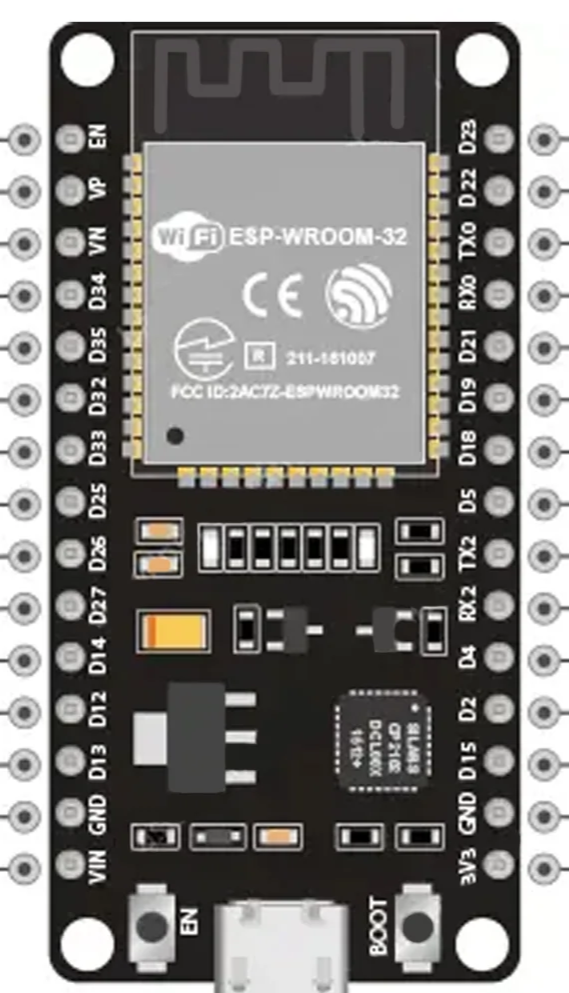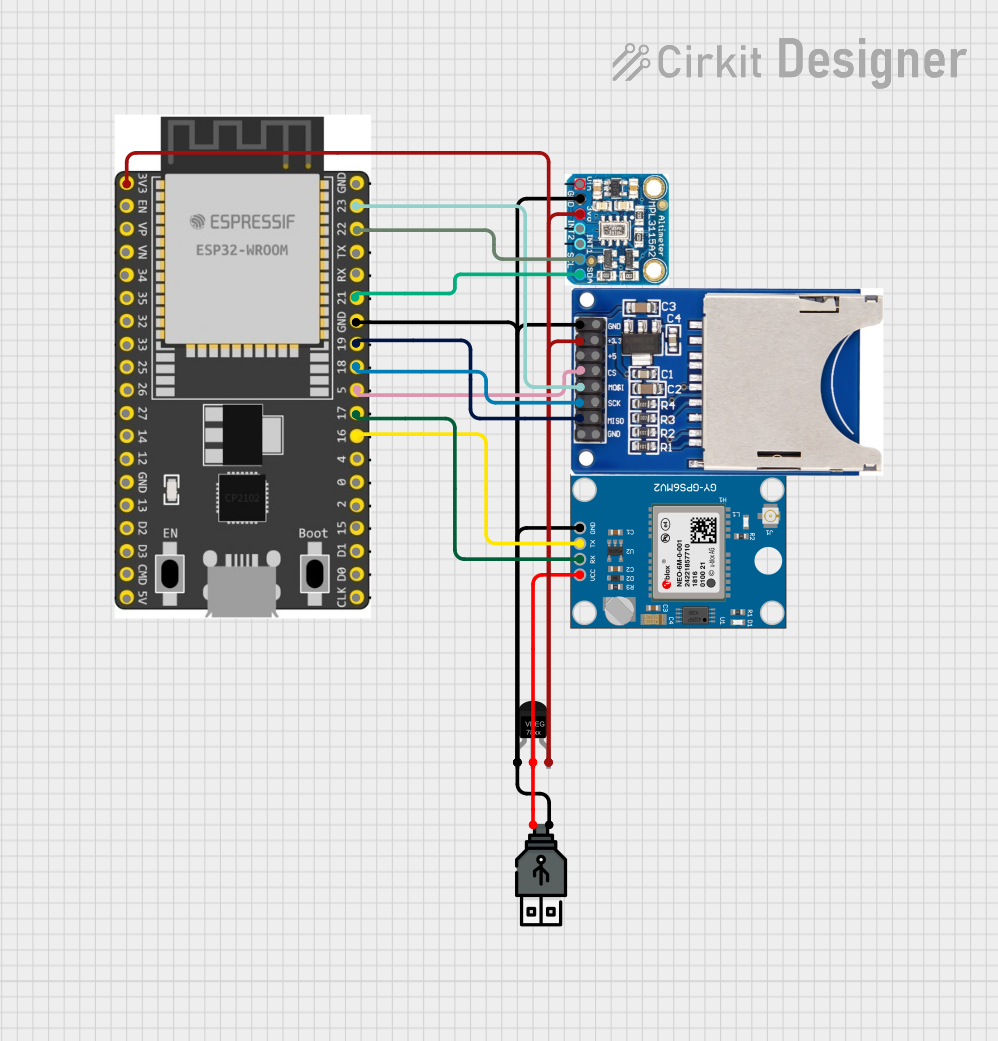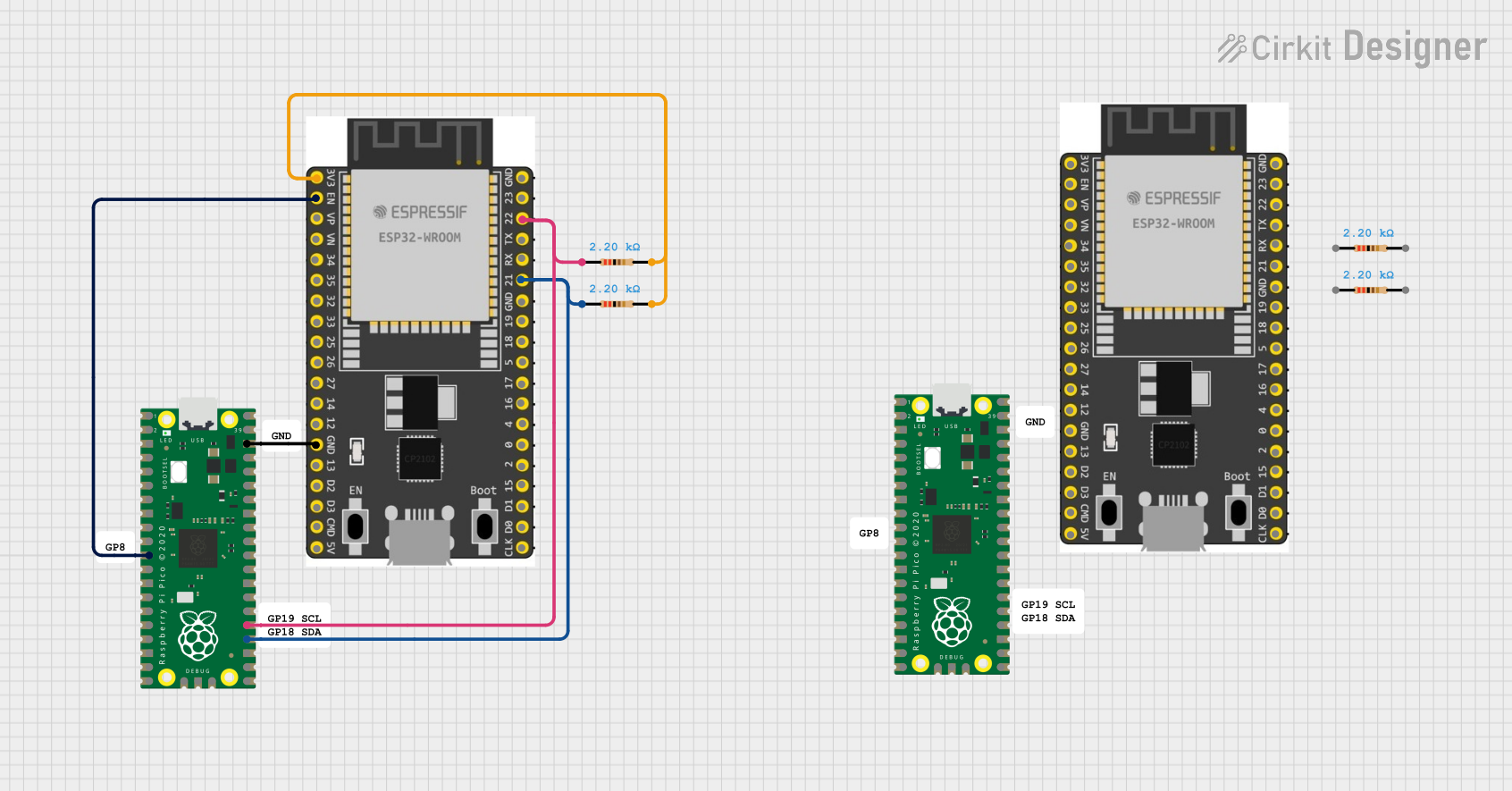
How to Use ESP32 Development Board ESP-WROOM-32: Examples, Pinouts, and Specs

 Design with ESP32 Development Board ESP-WROOM-32 in Cirkit Designer
Design with ESP32 Development Board ESP-WROOM-32 in Cirkit DesignerIntroduction
The ESP32 Development Board ESP-WROOM-32 is a powerful and versatile microcontroller board designed for a wide range of applications. It features built-in Wi-Fi and Bluetooth capabilities, making it an excellent choice for Internet of Things (IoT) projects, prototyping, and embedded systems development. With its dual-core processor, ample GPIO pins, and support for various communication protocols, the ESP32 is a favorite among hobbyists and professionals alike.
Explore Projects Built with ESP32 Development Board ESP-WROOM-32

 Open Project in Cirkit Designer
Open Project in Cirkit Designer
 Open Project in Cirkit Designer
Open Project in Cirkit Designer
 Open Project in Cirkit Designer
Open Project in Cirkit Designer
 Open Project in Cirkit Designer
Open Project in Cirkit DesignerExplore Projects Built with ESP32 Development Board ESP-WROOM-32

 Open Project in Cirkit Designer
Open Project in Cirkit Designer
 Open Project in Cirkit Designer
Open Project in Cirkit Designer
 Open Project in Cirkit Designer
Open Project in Cirkit Designer
 Open Project in Cirkit Designer
Open Project in Cirkit DesignerCommon Applications and Use Cases
- IoT devices and smart home automation
- Wireless sensor networks
- Wearable technology
- Robotics and automation systems
- Prototyping and educational projects
- Data logging and remote monitoring
Technical Specifications
Key Technical Details
- Microcontroller: Tensilica Xtensa LX6 dual-core processor
- Clock Speed: Up to 240 MHz
- Flash Memory: 4 MB (varies by model)
- SRAM: 520 KB
- Wi-Fi: 802.11 b/g/n
- Bluetooth: v4.2 BR/EDR and BLE
- Operating Voltage: 3.3V
- Input Voltage: 5V (via USB) or 7-12V (via VIN pin)
- GPIO Pins: 36 (multipurpose, including ADC, DAC, PWM, I2C, SPI, UART)
- ADC Channels: 18 (12-bit resolution)
- DAC Channels: 2
- Power Consumption: Ultra-low power consumption in deep sleep mode (~10 µA)
Pin Configuration and Descriptions
The ESP32 Development Board ESP-WROOM-32 has a total of 38 pins. Below is a table summarizing the key pin functions:
| Pin | Name | Description |
|---|---|---|
| 1-3 | GND | Ground pins for power and signal reference. |
| 4 | 3V3 | 3.3V output pin for powering external components. |
| 5 | VIN | Input voltage pin (7-12V) for powering the board. |
| 6-11 | GPIO0-GPIO5 | General-purpose input/output pins. Can be configured for ADC, PWM, etc. |
| 12-13 | GPIO12-GPIO13 | General-purpose pins. GPIO12 is often used for boot mode selection. |
| 14-15 | GPIO14-GPIO15 | General-purpose pins. GPIO15 can be used for PWM or SPI communication. |
| 16-17 | TXD0, RXD0 | UART0 transmit (TX) and receive (RX) pins for serial communication. |
| 18-19 | SDA, SCL | I2C data (SDA) and clock (SCL) pins. |
| 20-21 | MOSI, MISO | SPI Master Out Slave In (MOSI) and Master In Slave Out (MISO) pins. |
| 22 | EN | Enable pin. Pulling this pin low resets the board. |
| 23-24 | ADC1, ADC2 | Analog-to-digital converter channels. |
| 25-26 | DAC1, DAC2 | Digital-to-analog converter channels. |
| 27-36 | GPIO16-GPIO39 | Additional GPIO pins with various functionalities (ADC, touch, etc.). |
Note: Some GPIO pins have specific restrictions or are used during boot. Refer to the ESP32 datasheet for detailed pin behavior.
Usage Instructions
How to Use the ESP32 in a Circuit
Powering the Board:
- Use a micro-USB cable to power the board via the USB port (5V input).
- Alternatively, supply 7-12V to the VIN pin or 3.3V to the 3V3 pin.
Connecting Peripherals:
- Use the GPIO pins to connect sensors, actuators, or other peripherals.
- Ensure that the voltage levels of connected devices are compatible with the ESP32 (3.3V logic).
Programming the Board:
- Install the Arduino IDE or ESP-IDF (Espressif IoT Development Framework).
- Add the ESP32 board support package to the Arduino IDE.
- Connect the board to your computer via USB and select the correct COM port.
Uploading Code:
- Write your code in the Arduino IDE or ESP-IDF.
- Click the upload button to flash the code to the ESP32.
Important Considerations and Best Practices
- Avoid using GPIO6-GPIO11 for general-purpose tasks, as these are connected to the onboard flash memory.
- Use level shifters when interfacing with 5V devices to prevent damage to the ESP32.
- For low-power applications, utilize the deep sleep mode to conserve energy.
- Ensure proper grounding and decoupling capacitors for stable operation in noisy environments.
Example Code for Arduino IDE
The following example demonstrates how to blink an LED connected to GPIO2:
// Define the GPIO pin for the LED
const int ledPin = 2;
void setup() {
// Set the LED pin as an output
pinMode(ledPin, OUTPUT);
}
void loop() {
// Turn the LED on
digitalWrite(ledPin, HIGH);
delay(1000); // Wait for 1 second
// Turn the LED off
digitalWrite(ledPin, LOW);
delay(1000); // Wait for 1 second
}
Tip: Ensure the LED is connected to GPIO2 with a current-limiting resistor (e.g., 220Ω).
Troubleshooting and FAQs
Common Issues and Solutions
The board is not detected by the computer:
- Ensure the USB cable is functional and supports data transfer.
- Install the correct USB-to-serial driver (e.g., CP2102 or CH340).
Code upload fails:
- Check that the correct COM port and board type are selected in the Arduino IDE.
- Press and hold the "BOOT" button on the ESP32 while uploading the code.
Wi-Fi connection issues:
- Verify the SSID and password in your code.
- Ensure the router is within range and supports 2.4 GHz Wi-Fi.
GPIO pin not working as expected:
- Check if the pin is reserved for specific functions (e.g., flash memory).
- Ensure the pin is not being used by another peripheral or library.
FAQs
Q: Can the ESP32 operate on battery power?
A: Yes, the ESP32 can be powered by a LiPo battery connected to the VIN pin. Use a voltage regulator if needed.Q: How do I reset the ESP32?
A: Press the "EN" button on the board to reset it.Q: Can I use the ESP32 with 5V logic devices?
A: No, the ESP32 operates on 3.3V logic. Use level shifters for compatibility with 5V devices.Q: How do I reduce power consumption?
A: Use the deep sleep mode and disable unused peripherals to minimize power usage.
This documentation provides a comprehensive guide to using the ESP32 Development Board ESP-WROOM-32 effectively. For more advanced features, refer to the official Espressif documentation.